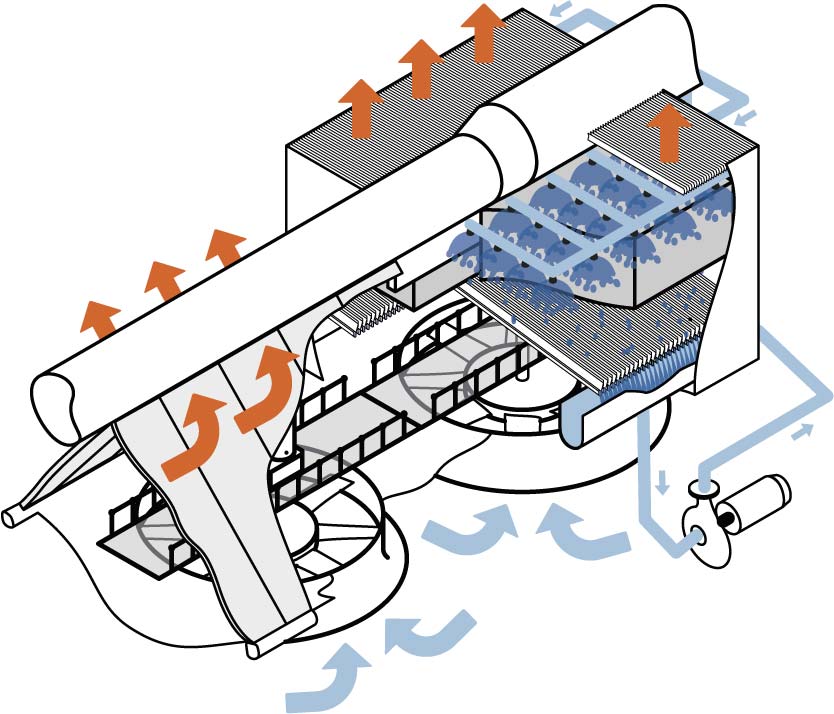
Hybrid dry/wet cooling systems

The scarcity of water in the arid locations that CSP plants are often erected in is one of the main drivers towards the use of dry-cooling (cooling with air) for power plant cooling purposes instead of a more conventional wet-cooling (cooling with water) approach. However, even though dry-cooling methods allow an order of magnitude reduction in cooling water consumption, the overall power cycle efficiency is generally lower compared to cases where wet-cooling is implemented.
In order to provide an improvement in the performance of a dry-cooling system for CSP applications the MinWaterCSP project focusses on the development of a novel hybrid cooling system (indicated in figure 1) that can be operated in a dry and wet mode, depending on the atmospheric conditions.
The hybrid system relies on the development of three sub-technologies:
- Higher efficiency low noise axial flow fans
- Wire heat transfer surface finned tubes
- Software tools for design and investigation
Contacts:
Albert Zapke – ENEXIO Management – (Deluge condenser and fan system testing)
Johan van der Spuy – SUN – (Large diameter fan design)

Axial flow fans
![]()
Large diameter axial flow fans find application in forced or induced draft air-cooled condensers. These fans are typically constructed by either using extruded aluminium sections or composite material lay-up techniques. These construction methods sometimes limit the performance of the final manufactured product. Additionally it only allows for a fixed number of fan configurations to be at the disposal of the cooling system designer. The following possibilities for improvement in large diameter axial flowfan design and manufacturing exist:
- The aerodynamic design of a fan rotor to simultaneously render high total to static efficiencies and low noise levels. The aerodynamic design will consider the manufacturing technique to be used for the fan blade.
- A blade manufacturing technique that would produce sufficiently stiff and light weight fan blades with a high level of accuracy (see figure 2). The manufacturing process will be adaptable in such a way that the manufactured fan can be tailored to the requirements of the cooling system designer.
- The integration of a high efficiency electrical fan motor and drive system that will specifically cater for the requirements of large diameter cooling fans.
Contacts:
Johan van der Spuy – SUN – (Large diameter fan design)
Chris Meyer – NOTUS – (Aerodynamic/structural design and manufacturing of axial flow fans)
Alessandro Corsini – University of Rome – (Fan noise aspects of large diameter fan developments)

M-Fan at Stellenbosch University

Wire structure heat transfer surfaces

Present state of the art heat transfer surfaces in large air cooled condensers mainly consist of galvanized steel tubes with aluminium fins in various configurations. Existing wire structure heat transfer surfaces can be adapted and developed for such applications. Main benefits of wire structures as heat transfer surface enhancement can be reduced material usage, higher heat transfer surface area as well as higher heat transfer coefficients. Therefore experimental and simulation based studies will be done on a variety of designs by Fraunhofer ISE, Freiburg. If successful, samples for laboratory testing will be manufactured and tested to determine heat transfer and air-side pressure drop characteristics. Should the outcome show benefits compared to existing state of the art technology, a cooling system design based on the new heat transfer and air-side pressure drop characteristics will be carried out and overall gains will be quantified.
Contacts:
Hannes Fugmann – Fraunhofer ISE

Software tools
Cooling system design tools play an important role in the design and development of new cooling systems. Kelvion Thermal Solutions is responsible for the development of performance prediction software for existing large scale cooling systems as well as a newly designed hybrid cooling system. The software is largely based on existing thermo-fluid dynamic theory and will be capable of predicting, among other things, heat transfer rates, steam-side flow distributions, water consumption and fan power consumption. The results obtained from the newly developed software will be used as input to existing CSP simulation software (ColSim), developed by Fraunhofer ISE that is used for the life cycle analyses of CSP plants.
Contacts:
Albert Zapke – ENEXIO Management – (Performance prediction software)
Shahab Rohani – Fraunhofer ISE – (ColSimCSP)
Fouling tests
Among other a main concern in deluged heat exchangers is the effect of fouling on thermal performance and the overall lifecycle. A containerized fouling test rig, consisting of four small cooling towers is therefore being designed and will be installed at Green Energy Park, Iresen in Morocco. The cooling towers will enable multiple accelerated investigations to determine the effect of fouling for different water compositions and various tube materials. Through the tests, effects of the following on thermal performance will be investigated:
- Scaling due to various salt compositions and concentrations
- Particle deposition due to different soil concentrations
- Water acidity
- Various rinsing strategies
- Tube temperatures
Contacts:
El Ghali Bennouna – IRESEN
